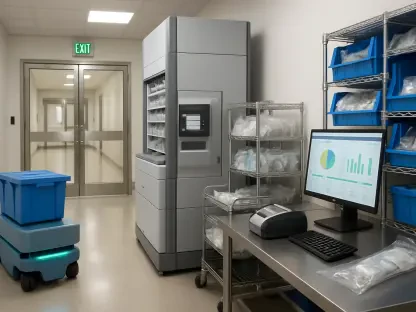Australia boasts a world-class health system and a thriving research sector, yet it struggles to support and scale local digital health startups. This challenge forces many promising companies to seek recognition and success in international markets. The disconnection within Australia’s public hospital system presents a significant barrier to the adoption and scaling of homegrown digital health technologies.
The Disconnect in Public Hospitals
Cost Minimization Over Innovation
Public hospitals, which account for nearly one-third of Australia’s $270 billion annual health expenditure, often prioritize cost minimization and large-scale purchasing agreements. This risk-averse approach hampers the adoption of cutting-edge technologies and limits opportunities for local health technology startups to compete and grow. The focus on immediate cost savings over long-term value and innovation stifles the potential for homegrown solutions to thrive.
This focus on cost minimization over innovation places local digital health startups at a significant disadvantage. These startups often develop pioneering solutions that require significant upfront investment but promise substantial long-term returns in the form of improved patient outcomes, reduced hospital stays, and enhanced operational efficiency. However, the current procurement practices emphasize short-term cost savings, making it difficult for innovative, yet initially expensive, technologies to gain traction. As a result, many Australian digital health companies must look overseas to find markets willing to invest in their solutions, leading to a brain drain and missed opportunities for the local economy.
The Harrison.ai Case Study
The $32 million investment in Harrison.ai by the National Reconstruction Fund Corporation (NRFC) is a positive step towards supporting Australian digital health innovation. However, this case also underscores the critical challenge of why Australian digital health companies often need to scale offshore before being recognized at home. Despite Harrison.ai’s success with large local private health providers, its limited adoption by public hospitals highlights the stark disparity between public and private sector support for innovation.
This situation is emblematic of the broader challenges faced by the Australian digital health sector. While private health providers are more open to innovative solutions that can enhance their competitive edge, public hospitals remain constrained by rigid procurement practices and a reluctance to deviate from established norms. This hesitation to embrace homegrown technologies not only hampers the growth of local startups but also deprives the public healthcare system of potentially transformative tools that could enhance patient care and operational efficiency.
Economic and Strategic Importance of Procurement
Procurement as a Strategic Investment
Procurement should be seen as a strategic investment rather than just a cost. The government can utilize its purchasing power to support local innovation, create jobs, and enhance economic resilience. By shifting procurement practices, Australia can foster a digital health sector that competes globally and drives both health outcomes and national economic growth.
A strategic approach to procurement recognizes that the true value of digital health technologies lies not just in immediate cost savings, but in their potential to drive long-term benefits. These benefits include improved patient outcomes, greater efficiency in healthcare delivery, and the creation of high-value jobs within the tech sector. By pivoting towards value-driven procurement, the government can play a pivotal role in nurturing a thriving digital health industry that delivers substantial returns on public investment.
Aligning Procurement with National Health Priorities
Establishing a coordinated procurement landscape ensures strategic investment in digital health solutions that meet Australia’s future healthcare needs. Aligning procurement with national health priorities can create a more supportive environment for local innovators and ensure that public investment translates into actual market opportunities within Australia’s healthcare system.
Proper alignment necessitates a nuanced understanding of the country’s health challenges and a commitment to addressing them through innovative solutions. This requires collaboration between various stakeholders, including healthcare providers, policymakers, and industry leaders, to identify priority areas where digital health technologies can make a significant impact. By creating a clear roadmap that aligns procurement decisions with these national health priorities, the government can ensure that its investments have the maximum possible impact on both the healthcare system and the broader economy.
Recommendations for a Supportive Procurement Ecosystem
Value-Based Procurement
Evaluating the long-term economic and clinical benefits of digital health solutions rather than focusing solely on immediate cost savings is crucial. Value-based procurement can drive the adoption of innovative technologies that offer significant long-term benefits, both economically and clinically. By shifting the focus from short-term expenditures to long-term value, Australia can create a more supportive environment for local digital health startups and help them scale within the domestic market.
This shift requires the implementation of new procurement frameworks that assess the full range of benefits offered by digital health solutions. These frameworks should account for not only cost savings but also improvements in patient outcomes, reductions in healthcare disparities, and enhancements in operational efficiency. By adopting such value-based approaches, procurement officers can make more informed decisions that support both the healthcare system’s immediate needs and its long-term goals.
Clear Pathways for Local Innovators
Providing structured opportunities for SMEs to pitch their solutions, backed by procurement tools and incentives, can facilitate their adoption. Creating clear pathways for local innovators ensures that they have the support needed to compete and grow within the Australian healthcare system. This involves not only opening up procurement processes to smaller companies but also providing them with the resources and guidance needed to navigate these processes effectively.
These pathways should include mechanisms such as pilot projects, innovation hubs, and accelerator programs that allow startups to demonstrate the value of their solutions in real-world settings. By giving local innovators a platform to showcase their technologies, the government can foster a vibrant ecosystem where new ideas are tested, refined, and scaled to meet the healthcare sector’s evolving needs. Additionally, procurement policies should prioritize collaborations between startups and established healthcare providers, ensuring that innovative solutions are integrated seamlessly into existing workflows.
Innovation-Friendly Procurement Environment
Encouraging early-stage investment in emerging technologies instead of resorting to established multinationals fosters a dynamic, innovation-friendly procurement environment. This approach can help local startups gain traction and scale within the domestic market. By creating an ecosystem that prioritizes innovation over tradition, Australia can position itself as a global leader in digital health.
This innovation-friendly approach requires a cultural shift within procurement agencies, moving away from a risk-averse mindset towards one that embraces experimentation and learning. Early-stage investment in emerging technologies allows procurement officers to identify and support high-potential startups that might otherwise struggle to gain a foothold. Additionally, fostering strong networks between industry, academia, and government can lead to more collaborative and innovative solutions, accelerating the development and adoption of cutting-edge healthcare technologies.
Aligning Government Funding with Procurement Decisions
Translating Public Investment into Market Opportunities
Ensuring that public investment in digital health innovation translates into actual market opportunities within Australia’s healthcare system is essential. Aligning government funding with procurement decisions can create a more cohesive and supportive ecosystem for local digital health startups. This alignment helps ensure that investments in research and development lead to tangible benefits within the public health sector.
To achieve this, the government must create synergies between funding agencies, research institutions, and procurement offices. Clear communication and collaboration between these entities can ensure that the technologies receiving investment are given fair opportunities within the procurement process. This integrated approach reduces the disconnect between innovation and adoption, fostering a more cohesive system where innovative solutions are not only developed but also implemented widely.
Mandatory Reporting and Tracking
State health authorities and the Commonwealth should track and report local procurement targets for digital technology. Mandatory reporting and tracking can ensure accountability and transparency, driving progress toward a more supportive procurement ecosystem. By making this data publicly available, stakeholders can better understand the effectiveness of current procurement practices and identify areas for improvement.
Regular reporting on local procurement targets provides valuable insights into the progress being made and highlights any gaps that need addressing. This transparency fosters trust and ensures that procurement practices are aligned with broader policy goals. It also encourages continuous improvement, as stakeholders can learn from both successes and challenges. As a result, the procurement ecosystem becomes more adaptive and responsive to the needs of local digital health startups, facilitating their growth and integration into the healthcare system.
Positive Steps and the Need for Further Action
National Digital Health Strategy
The National Digital Health Strategy envisions a connected and digitally-enabled healthcare system. Recent procurement reforms, such as the new Commonwealth Procurement Rules and the NSW Procurement Board mandates, support SMEs and local suppliers, indicating positive steps toward supporting local digital health innovation. These reforms represent a significant shift towards a more inclusive and forward-thinking procurement landscape that values local contributions.
However, these positive steps must be built upon to ensure sustained progress. Continued investment in digital health infrastructure, education, and training is needed to support the effective implementation of innovative solutions. Moreover, these reforms should be regularly reviewed and updated to keep pace with technological advancements and evolving healthcare needs. By maintaining a dynamic and adaptive approach to procurement, Australia can continue to foster an environment where local digital health innovation thrives.
The Case of Harrison.ai as a Wake-Up Call
Australia prides itself on having a top-tier health system and an active research community. Despite these strengths, the country faces difficulties in supporting and expanding local digital health startups. This issue compels many innovative companies to search for acknowledgment and achievements in international markets rather than on home soil. A major obstacle to this growth is the disjointed nature of Australia’s public hospital system, which significantly hinders the acceptance and expansion of domestic digital health technologies.
Australia’s digital health startups are often left without the support they need to thrive locally due to systemic fragmentation. To unlock their full potential, there needs to be a concerted effort to streamline the public hospital network and create an ecosystem that nurtures innovation. Addressing these challenges could position Australia as a leader in the global digital health space, encouraging local developments to flourish domestically and internationally. For Australia to truly capitalize on its medical expertise and research capabilities, overcoming these obstacles is essential.









